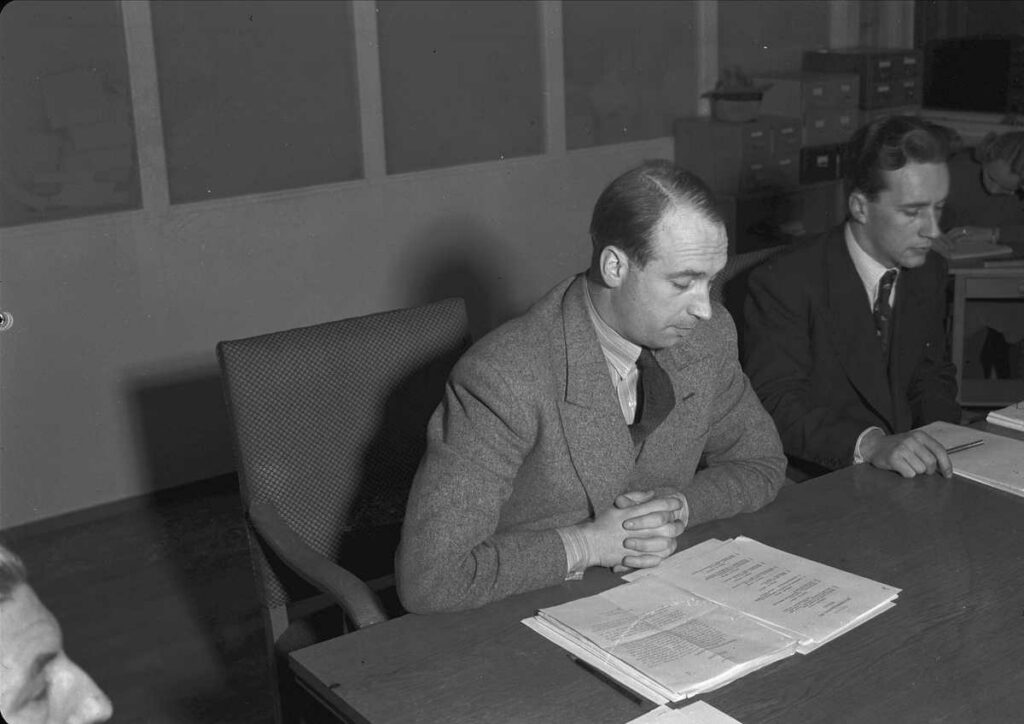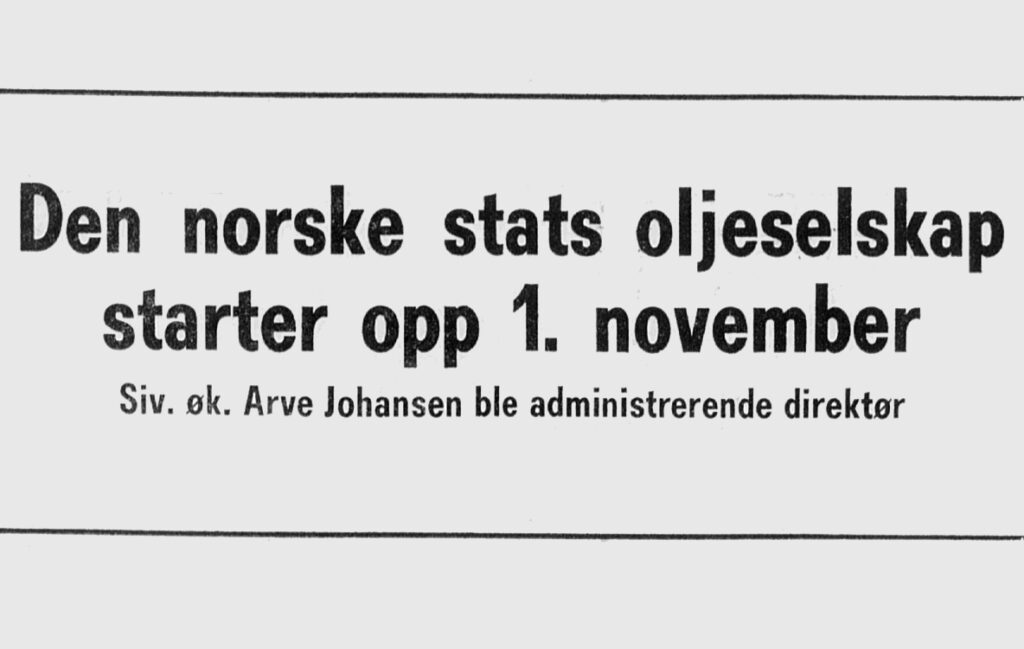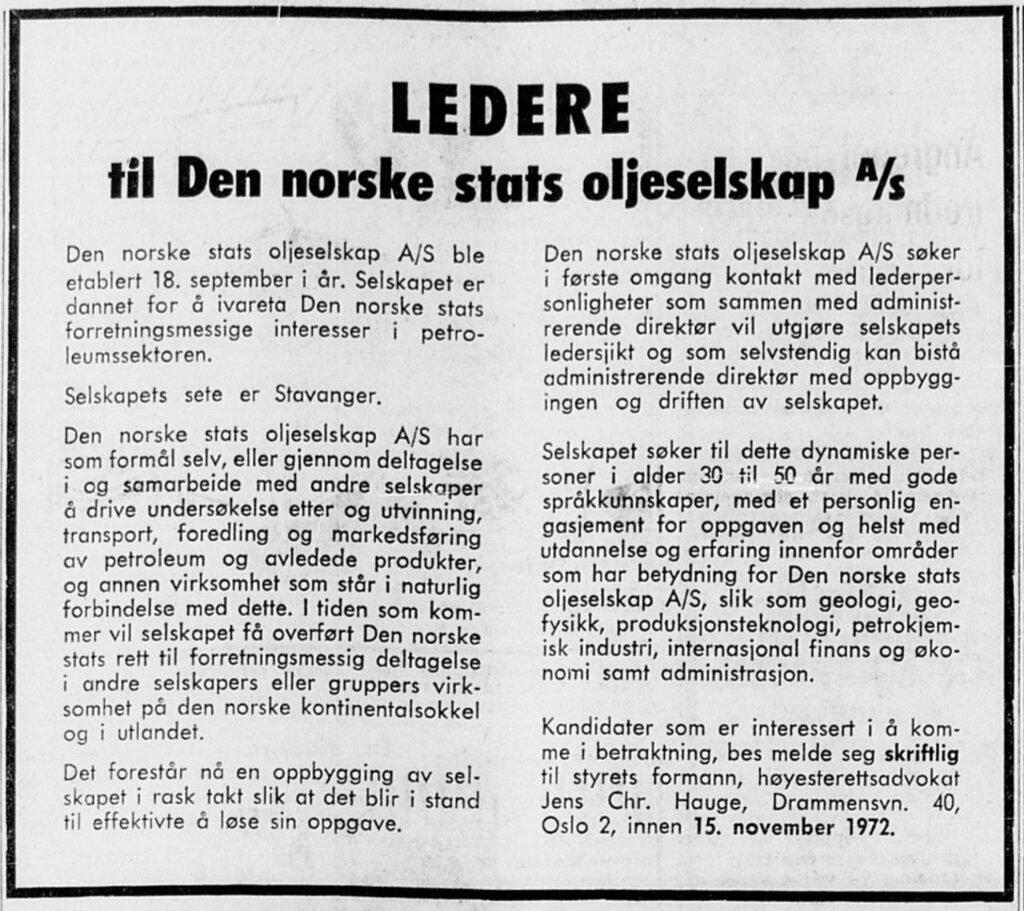Board appointed – and appoints

The first step was to put a board of directors in place. It had been decided that the company’s general meeting, comprising the responsible government minister, would appoint its members. In June 1972, that person was Finn Lied from the Labour Party.
He was accordingly present as promoter at the statutory general meeting of the company on 18 September 1972, along with his state secretary Arve Johnsen (later to become CEO). Also attending from the Ministry of Industry were secretary general O C Müller, director general Knut Dæhli, division heads Harald A Sommernes and Karl-E Manshaus from the ministry’s oil office, and consultant Nils Heilemann. Furthermore, representatives from the Auditor General’s office were present along with supreme court attorney Jens Christian Hauge as chair-designate of the board.[REMOVE]Fotnote: Minutes of the statutory general meeting of Den norske stats oljeselskap a.s. SAST/A-101656/0001/A/Aa/Aaa/L0001. Accessed at https://www.digitalarkivet.no/oe10511205100002.

Together with Johnsen, Lied had clarified at an early stage who he wanted as chair of the company. The government approved his proposal to give the job to Hauge, his close friend and ally.[REMOVE]Fotnote: Njølstad, O, Jens Chr. Hauge: Fullt og helt, Aschehoug, 2008, Oslo: 630. Both had been active in the resistance to the German occupiers during the Second World War and were members of Labour’s inner circle. During the 1960s, they had helped to frame the party’s programme.[REMOVE]Fotnote: Wicken, Olav, “Finn Lied”, Norsk biografisk leksikon, snl.no, 12 October 2014. Accessed 26 June 2020 from https://nbl.snl.no/Finn_Lied.
Hauge was a lawyer and politician. Following his wartime role as a leader of Milorg, the main Norwegian resistance organisation, he became defence minister in 1945 at the age of 30. After stepping down as defence minister in 1952, a new post at the Labour Party offices gave him an active role in shaping Norwegian industry policy.
He was responsible for establishing the Norwegian Defence Research Establishment in 1946, where Lied became head of research in 1957. The latter was moreover to be his successor as Statoil chair in 1974.
Vidkunn Hveding, an engineer and Conservative politician, was appointed deputy chair of the new company. His experience from various parts of the energy supply sector and the management expertise acquired in the same industry made him a professional expert. He also brought with him broad international experience through advisory and consultancy roles in such countries as Ethiopia, Brazil and Kuwait as well as a number of offices in industry and shipping.
The general meeting furthermore elected Aksel Fossen, a Storting representative from Labour who had served in the Norwegian merchant navy through six wartime years and was one of Norway’s most respected industry politicians. He was known as the “power socialist” from Odda near Stavanger.[REMOVE]Fotnote: Commemorative speech on former representative Aksel Fossen, Storting session of Thursday 22 October 2009 at 10.00.
In addition came the Conservative Party’s Per Mauritz Hanssen from Kaarbøs Mekaniske Verksted in Harstad. Finally, senior lecturer Aage Solbakken in the department for industrial chemistry at the Norwegian Institute of Technology (NTH) was appointed an alternate director.

The composition of the board gave the impression of a political compromise between the two biggest parties of the day – two from Labour and two from the Conservatives. The common denominator of these directors was that their expertise from different fields, industries and political persuasions was relevant to Statoil’s business.
Although it was due to sit until the annual general meeting in 1975, the whole board actually stepped down abruptly a year early.
Personnel required
“National management and control” was the overall goal of Norwegian oil policy from the early 1970s. Where Statoil was concerned, this translated into technological control.
One way of achieving that was the rapid build-up of an organisation which mastered all the technical challenges faced when operating in the North Sea. That called in turn for recruiting the best team in terms of technological expertise.[REMOVE]Fotnote: Ryggvik, Helge, Til siste dråpe, 2009, Aschehoug, Oslo: 96.
As early as the day after the statutory general meeting of Den norske stats oljeselskap a.s, Hauge called the company’s first board meeting. That was held on 5 October 1972 at Drammensveien 40 in Oslo, and its most urgent priority was to put a management team in place.
The first step was to appoint a vigorous and visionary chief executive. This job was advertised, but Hauge quickly saw that the applicants were “pretty much of a disappointment”. In consultation with Lied and Müller, it was agreed to look around for other candidates.
Several were assessed, but the choice fell on Johnsen, who was leaving his post as state secretary at the industry ministry owing to a change of government.[REMOVE]Fotnote: Njølstad, O, op.cit: 631. With degrees in business economics and law, he had experience from the oil industry as well as the innermost circles of petroleum policy-making. According to the board minutes, he was “a person all the directors knew as an unusually able man and an outstanding leadership type”.[REMOVE]Fotnote: Minutes, board meeting, Den norske stats oljeselskap a.s, 5 October 1972. SAST, Pa 1339 – Statoil ASA, A/Ab/Aba/L0001: Styremøteprotokoller, 05.10.1972-14.12.1978, 1972-1978: 9 Hauge argued that no further candidates needed to be called in.

At the same meeting, the chair was given the board’s blessing to place job advertisements in a number of Norwegian newspapers and selected foreign oil journals.[REMOVE]Fotnote: Minutes, board meeting, Den norske stats oljeselskap a.s, 5 October 1972. Accessed at http://urn.digitalarkivet.no/URN:NBN:no-a1450-db60034661000003.jpg. These sought applications from “dynamic people” aged 30-50 with qualifications and practical experience in such areas as geology, geophysics, petroleum technology, petrochemical industry, international finance and economics, and administration. Putting a management team in place was the first priority.
Johnsen was appointed CEO in December 1972, and the first interviews could then be held with relevant applicants for other posts. No job descriptions were drawn up. Johnsen wanted decisive colleague with independent views and operational experience. Those looking for formal positions or titles were rejected.[REMOVE]Fotnote: Johnsen, A. (1988). Utfordringen: Statoil-år. Oslo: Gyldendal.s.26 “I was determined not to appoint people with such ideas,” Johnsen wrote in his first memoir.[REMOVE]Fotnote: Ibid: 26.
The company had few problems recruiting competent Norwegians for financial and administrative roles or general engineering posts. But petroleum expertise was less easy to find.
